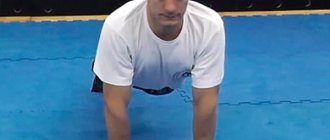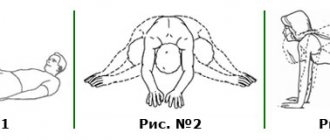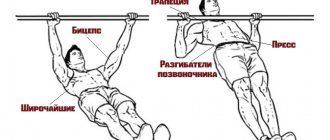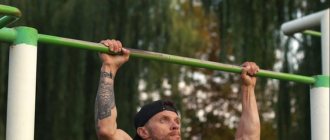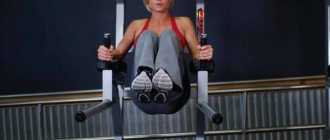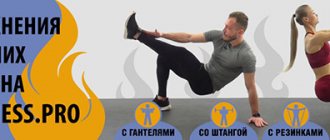Author: Timko Ilya - the ruler of the entire site and fitness trainer | more details >> Rod. 1984 Trained since 1999 Trained since 2007. Author and creator of the site tvoytrener.com. CCM in powerlifting. Champion of Russia and South Russia according to AWPC. Champion of the Krasnodar region according to IPF. 1st category in weightlifting. 2-time winner of the Krasnodar Territory championship in t/a. Author of more than 700 articles on fitness and amateur athletics. Author and co-author of 5 books.
Place in the ranking of authors:
out of competition
(become an author)
Date:
2016-08-12
Views:
68,514
Rating:
5.0
| All articles by the author >> | Medals articles >> |
Articles are loading...
Now I will tell you about such an interesting and rare method as the one-approach method. What it is?
The one approach method is that you do each exercise only one working approach but until complete failure.
What does this look like in practice? Well, for example, you want to practice your back today. Typically (for example) you do 3 exercises on your back:
- Wide grip chest pull-ups 3 sets
- Bent-over barbell row 3 sets
- Horizontal block row 3 sets
But if you suddenly decided to shake your back using one approach, it would look like this (it would take the same amount of time and effort):
- Wide grip chest pull-ups 1 set
- Wide grip head pull-ups 1 set
- Reverse grip pull-ups 1 set
- Bent-over barbell row 1 set
- Bent-over dumbbell row 1 set
- Horizontal block row 1 approach
- Narrow handle lat pulldown 1 set
- Lever pulling 1 set
- Lying pullover with dumbbells 1 approach
Of course, I didn’t give an example of the entire workout, but only one muscle group. Do you agree that it looks much more interesting? I think you get the point. Let's now look at the advantages of this method.
https://youtu.be/t35S3Jas2QE
How to Train for Maximum Muscle Growth
There are 3 main methods to stimulate muscle growth:
- Load progression - aimed at increasing strength and constantly increasing working weights.
- Cellular Fatigue - Metabolism in muscle cells is pushed to the limit by high repetitions. Also commonly called pumping. A very common method in bodybuilder training.
- Muscle damage - training for micro-tears of contractile fibers. Typically accompanied by muscle pain and called muscle pain (DOMs). Although muscle pain does not always mean muscle growth.
The best training method for gaining muscle mass quickly is to focus all your attention on progressive loads and muscle failure in the last sets.
Many studies have demonstrated that progressive overload is the most effective method of stimulating muscle growth.
Eg:
- 1 approach - 100 kg.
- 2nd approach - 110 kg.
- 3rd approach - 120 kg.
- 4th approach - 135 kg.
When you do 4 sets of 6 reps, the first two sets will be relatively easy for you. The third is difficult, and in the fourth you should reach muscle failure. That is, 4, 5 or 6 repetitions simply cannot be completed (or with great effort). 80% of the time in the gym it is desirable to train this way, regardless of the muscle group. Again, all this is aimed at increasing strength indicators. Strength gains are very important because they typically precede muscle growth in natural athletes. Let's give an example. In one study, 33 participants were divided into two groups:
- 4 workouts per week - four sets of 10-12 repetitions with 70% of one-rep maximum (1RM).
- 4 workouts per week - four sets of 3-5 reps with 90% of 1RM.
90% of a one-rep max is a much greater load on the muscles than 70%. And it activates a large number of fast type 2 muscle fibers .
Due to this, you can lift very heavy weights. Naturally, it will not be possible to do 10-12 approaches with a very heavy weight (90% of 1RM). You'll stop at reps 2-5. The programs in both groups were composed of the following exercises: squats, deadlifts, bench presses and military presses. After 8 weeks, participants in the second group gained much more strength and gained more muscle mass. Again, it all came down to activating type 2 fast muscle fibers. It is their stimulation that determines how much muscle mass a natural athlete can gain per month. And for this there is nothing better than performing sets with heavy weights for low reps. This doesn't mean that higher rep sets are useless. The volume of such training (total number of repetitions) is usually very large. But there is no need for our body to recruit type 2 muscle fibers unless we perform sets to muscle failure. And with a large number of repetitions, type 1 fibers are trained, which are responsible for endurance. Many sports studies have proven that training strength and endurance at the same time, unfortunately, does not produce results. If you don't reach muscle failure, high-repetition sets (pump training) will only lead to the development of endurance. And if you achieve it, then it will be excessive violence against the body. Will quickly lead to overtraining. There is no chance of sufficient rest and recovery between such training sessions. Unless, of course, you take steroid drugs.
Advantages of the One Approach Method
1. More inclusion of muscle fibers. By doing 3 sets of different exercises to failure, but aimed at the same muscles, you will engage more muscle fibers in the work than if you did 3 sets of one exercise. This means that there will be more stress on your muscles, and they will grow in mass and strength more easily.
2. This method makes your workouts more varied and not boring. After all, you will do several times more exercises in one workout. And you will agree that doing several identical approaches is quite boring.
3. For those who put less weight in the first working approach with the words: “This is so that in the last approach I can do the required number of repetitions” - now you can forget this fear of yours. After all, you no longer have a first and last approach. Every approach is the last! And you must make the most of it!
So how much exercise should you do?
That's why, on average, one workout should consist of 3-5 exercises.
3 heavy basic exercises and 1-2 isolating exercises at the end. When training with weights of 75-80% of your one-rep max, you will be able to do 6-8 reps per set, respectively. For example, chest training:
- Bench press on an incline bench 3×6-8.
- Bench press 3×6-8.
- Dumbbell bench press on an incline bench 3x6-8.
- Lying dumbbell fly 3×6-8.
And 1-2 warm-up approaches before each movement. The total volume of the workout is 72-96 repetitions . Most studies have come to this conclusion. It's enough.
With loads ranging from 60-85% of your one-repetition maximum (1RM), the 90-180 rep range is ideal for stimulating muscle growth.
Documentation
- Training schedule for the current year . The schedule is developed by the person responsible for fire safety and approved by the manager. The schedule must indicate the planned date of the training, its type and participants.
- Instructions for conducting fire drills (plan). Approved by the head of the enterprise, developed by the person responsible for fire safety together with the heads of structural divisions and heads of engineering services of the enterprise.
- Order on preparation and conduct of training. Issued by the head of the enterprise, the order includes all the information from the schedule for the next planned training.
- Training plan. A specific plan for preparing and conducting the next training session - the document contains information about the purpose, composition of participants, calendar plan for preparation for training, etc.
- Report on the results of the training.
- Fire training logbook. Filled out by the person responsible for fire safety in the organization. The log indicates the date, location, type of training and information about the participants.
- Order based on the results of fire training. Published by the head of the organization. The document describes the results of the training and prescribes measures to eliminate identified deficiencies and errors.
Don’t forget: training on evacuation of people in case of fire must be carried out every six months!
We wish you successful training!
Effective exercises
There is no need to chase variety. To improve results, you need to stop following the principle: the more, the better. Again, let’s take chest training as an example. What is the best way to stimulate chest muscle growth? Bench press on a horizontal and inclined bench. They give maximum results. Unfortunately, lying dumbbell flyes were not even close to them. Few would argue with this. Therefore, to conduct a good chest workout, you need to perform several approaches to each of these exercises. But if you do them with light weights, then it doesn’t matter how many approaches you do. The point is that if you do the exercises as expected, then there will not be much energy left to continue training . So there's no point in trying to do another 5-7 on top! If you don’t want to completely “destroy” your muscles. This is the most important thing to understand when deciding how many exercises to do per workout. Do enough to stimulate strength gains and go home. This is called the minimum effective dose . Notice the word "minimal". A minimalistic approach produces better results than trying to squeeze out the maximum. And you don’t hold back, but give it your all, since you only do 5 exercises. Eight-time Mr. Olympia Lee Haney said, “Exercise is about stimulation, not destruction.” And six-time Mr. Olympia Dorian Yates (Dorian Yates (Yates)) gave an analogy with sandpaper. If you rub your palms with sandpaper, they will turn red. Then let them rest and repeat again several times, as a result calluses will form. On the other hand, if you rub them until they bleed and keep rubbing, they will never heal. You get the point. The maximum usually leads to fatigue and overtraining. Without recovery there will be no muscle growth. The same as without a push for growth - stimulation. That's why you need to focus all your attention on the best few exercises for each part of the body.
Focus on the best exercises for each muscle group
Breast
Incline Bench Press . It is better to perform with both dumbbells and a barbell. If you train your chest 2 times a week, then, of course, you can split them. Or do one thorough chest workout once a week.
Bench press lying on a horizontal bench. Certainly one of the best and most popular exercises.
Shoulders
The military press is the best type of load for working the shoulder muscles.
Swing dumbbells to the sides. This is, of course, an isolation exercise, but it really helps to broaden your shoulders.
Back
The deadlift is arguably the best exercise for gaining muscle mass. With its help you can pump up a powerful, sculpted back. But it can just as well be considered an exercise for the legs.
Bent-over barbell row.
One-arm dumbbell row.
Upper block thrust . Its effectiveness is usually underestimated. One of the best movements for working the latissimus dorsi muscles.
Pull-ups on the bar. They must be done. If you don’t know how to do pull-ups, then most gyms, as a rule, have a pull-up machine - a gravitron. With its help, you can gradually strengthen the muscles necessary for pull-ups.
Legs
Squats with a barbell on the back. Very effective for training leg muscles - you can’t argue with that. However, many people prefer to do front squats.
Front squats. They develop the quadriceps muscles of the thigh better than the classic version. Allows you to squat deeper. They put less stress on the knees and lower back, making them ideal for strengthening the knee joints. The downside is that you won't be able to use very heavy weights and it requires quite a bit of wrist dexterity. Therefore, many athletes cross their arms this way:
Romanian deadlift. It is typically not included in most training programs. It's a pity. Because this is the best type of load for developing the hamstring muscles.
Hands
Barbell curl for biceps . As a rule, our arms receive enough load when training other parts of the body. For example, the biceps and forearms are seriously loaded when performing many basic exercises and various deadlifts. And the triceps are involved in most presses (bench press, military press). Nevertheless, lifting the barbell for the biceps and additional training of the triceps help to create impressive volume and relief of the arms.
Abdominal muscles
Crunches . If done 2 times a week, then this will undoubtedly play an important role in the formation of six-pack abs. Roller exercises are very effective if done correctly.
The right approach to training
Many people want to look beautiful and natural. Men want steel biceps and sculpted “cubic” bellies. Girls dream of toned buttocks and thin waists. For many, dreams remain dreams (it’s better to lie on the couch, watch TV and just dream), but some purposefully go to the gym to make their dreams come true. But this is where the fun begins. Despite all his hard work, spending endless hours in the gym and washing his face afterwards, a person can simply leave his body without significant changes, wasting time and energy.
Every person can change the state of their body and health for the better; they just need to have the minimum knowledge of a beginner that will help in further training. This is where the Internet and literature that tell you about bodybuilding for beginners will help you.
Firstly , you need to decide on the goal of what exactly the person who has decided to start his own transformation wants: to give himself a little shape or to pump himself up to incredible sizes, or maybe he just wants to lift the maximum weight or his life’s dream is broad shoulders.
Secondly , when the goal is determined, it is necessary to reconsider your diet, because the construction of our body or bodybuilding depends 35% on nutrition, 35% on genetics and only 30% on training. If a young guy is overweight and, in order to normalize it, does not get off the treadmill and does exhausting exercises, and in the evening eats packs of chips and beer, then such training is worthless.
Thirdly , in order to achieve the desired goal, you need to adjust your lifestyle to your workouts, turn them into your habit, and then the body will respond with gratitude in the form of elastic muscles and general tone. You need to know that each person is individual, each has their own genetics and there is no panacea for increasing muscle mass. There are just a few general rules for everyone that it would be recommended to adhere to:
Rule 1. The most important thing is safety for your own health; the best workout is one in which a person enjoys feeling the work of his muscles.
Rule 2. Follow the technique. Technically performed exercises naturally give more effective results.
Rule 3. To increase the overall tone of muscle mass, it is recommended to perform basic exercises that involve several muscle groups.
And, of course, you need to remember that there are no ideal figures; there is always room for striving forward, for improving your results and for your own self-satisfaction from achieved goals.
What about a full body?
The same rules apply to full body training. It is important to give an incentive to the growth of each muscle group, but not to strain, not to “kill” them. Prohibitively excessive loads are the main reason why fullbody training in CrossFit, as a rule, is not very effective for muscle growth. If you do intense CrossFit workouts several times a week, you end up performing more than a dozen different strength movements for each muscle group. You don't allow your muscles to recover. Or another option: you’re just trying to at least go through these 10 exercises with practically no effort. Deep down, you are only concerned with conserving energy so that you have enough for all these strength loads, losing weight, and at the same time stimulating virtually no fast-twitch type 2 muscle fibers. Plus, many of these exercises come from weightlifting. They are very heavy and weightlifters never perform them in such quantities. In other words, if you include several of these movements in one training session, it is guaranteed to have a negative effect. It's best to think of a fullbody as 4 or 5 workouts combined together. Typically the split might look like this:
- Monday - chest;
- Tuesday - back;
- Wednesday - hands;
- Thursday - shoulders;
- Friday - legs.
When trying to work all these muscles in one day, it is important to strictly adhere to minimalism. This means no more than 2 strength movements per muscle group. The result will be something like this:
- Chest - 2 exercises.
- Back - 2.
- Shoulders - 2.
- Legs - 2.
This is why a fullbody is not the most effective option for gaining muscle mass. Imagine doing basic exercises for each muscle group in one day. You will quickly exhaust yourself. It is very difficult to maintain sufficient energy levels throughout the entire training session to hit each muscle group well. In addition, the body needs much more time to recover from such stress.
Bodymaster.ru recommends Training Plans:
After the coach and bodybuilder discussed training and the lack of progress - in particular in the bench press - the decision was made to take a break from training for three weeks. The bodybuilder said he couldn’t stop going to the gym for such a long period of time. This is a common problem among all serious bodybuilders. Psychologically, if you want to make progress, it is very difficult to do what seems like “doing nothing.” After all, if you don’t train, it’s like you’re admitting defeat. But in reality, your body needs time to recover. And this is the perfect time to think about how often to train next and create a new training plan. Time away from training is not wasted time; it is critical to the growth process. It took a lot of convincing to convince him, and he took a three-week break.
Two months later, he called the coach and told him about the results, which shocked everyone. His strength increased in all parts of his body and his shoulder power increased. The first workout after the break became his personal record. Now he trains once every nine days: 9 days pass between training the same body part. This schedule is used when dividing workouts for the upper/lower body. Before this adjustment in training frequency, the bodybuilder trained only four times in nine days. Look at the numbers, they clearly illustrate the example.
| October 11 | November 8 | December 17 |
| 160 kg, 20 reps | 180 kg, 20 reps (light) | 180 kg, 20 reps (light) |
| 180 kg, 20 reps (very difficult) | 200 kg, 20 reps | 230 kg, 20 reps |
| 230 kg, 16 reps | 270 kg, 12 reps |
The bodybuilder did not include the time it took him to press, so his power factor or index is not known, but his total bench weight went from 6,940kg per workout to 11,460kg after doing nothing for three weeks. When was the last time you had such a productive three-week break?
Think about it. Three weeks without training at all! Our hero has only been sitting at home for three weeks, but his progress is ahead of everyone he trained with! His partners couldn't believe their eyes. The same person who thought 20 reps with a 180kg weight was "very difficult" now lifts 230kg for 16 reps - after doing the exercise with 200kg for 20 reps! The next time he bench presses 270 kg in the gym. And don't let his goofball buddies worry that he's "missed" his last 20 workouts! Something to think about, isn't it? Maybe it's time to reconsider your training frequency?
Main conclusions
Two things are needed for muscle growth:
- Stimulation (strength load).
- Recovery (time after exercise).
Restoration is in every way just as important (if not more) than stimulation. But very often what happens is that people train until they are completely exhausted. And they don’t give the muscles any chance to recover. Therefore, limiting loads to a minimum, as a rule, works much more efficiently in practice. For example, all that is needed for small muscle groups is 2-3 exercises per workout. And if at the same time the muscles do not grow, it means that you are not training intensively enough (there is no progression of load and muscle failure) or you are not eating and recovering correctly. 3-5 exercises for a large muscle group is all that is needed. At the same time, do not hold back, give your all in every approach. You definitely have enough energy for this. This is the training strategy.
Good luck
